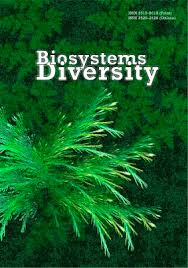Distribution of adventive species Solidago canadensis, Phalacroloma annuum, Ambrosia artemisiifolia, Heracleum sosnowskyi in phytocenoses of Volyn’ Polissya (Ukraine)
Distribution of adventive species Solidago canadensis, Phalacroloma annuum, Ambrosia artemisiifolia, Heracleum sosnowskyi in phytocenoses of Volyn’ Polissya (Ukraine)
Author(s): L. V. Oitsius, H. P. Volovyk, S. P. Doletskyі, A. V. LysytsyaSubject(s): Agriculture, Sociobiology
Published by: Дніпропетровський національний університет імені Олеся Гончара
Keywords: plant invasions; adventive plants; drainage melioration; anthropogenic transformation of phytocenoses;
Summary/Abstract: Biological pollution of natural phytocenoses by adventive plant species poses is a serious threat to endemic species and species with narrower ecological amplitude in ecosystems around the world. This study presents the results of a study of the composition and distribution of adventive plant species in natural, semi-natural and anthropogenic transformed phytocenoses of Volyn’ Polissya, Ukraine. To clarify the effect of drainage melioration on non-native flora species distribution, a botanical study was carried out during the 2003–2019 vegetation seasons on the territory of four drainage systems. The adventive flora of this unique region of Europe was studied in detail for the first time. In total, 279 non-native plant species were found. They belong to 110 genera and 32 families. The results of studying the systematic, bioecological, range-distributional and phytogenetic structure of adventive species found within agricultural lands and adjacent territories are presented. It was found that 161 species are associated with agricultural production. Of these, 90 species were found directly within the agricultural land, another 71 species were found growing in the adjacent territories. It was found that a significant increase in the number of adventive species on the territory of Volyn’ Polissya is associated with drainage melioration carried out in the 1960–1990s, significant changes in the structure and forms of agro-industrial production, and climatic changes in recent decades. The expansion of agricultural land in this area over the past 50–60 years has led to an increase in the number of adventive species by more than 60%. On the territory of drainage systems used for agricultural activities, more than 40% of the total species composition of the adventive flora of Volyn’ Polissya is represented. The majority of these species originate from arid and sub arid regions of the planet. The transformer plants, Solidago canadensis L. and Phalacroloma annuum (L.) Dumort pose a potential threat to phytocenoses of the described region, as well as the whole of Europe. Of particular interest are the species that in the future may pose a serious threat to natural phyto-diversity and have negative practical consequences for the structure of agricultural landscapes. These are Ambrosia artemisiifolia L. and Heracleum sosnowskyi Manden. In general, modern agro ecosystems are characterized by instability and low ability to resist non-native species. The strongly weedy character of cultivated fields and the presence of abandoned uncultivated lands have caused the rapid spread of adventive vegetation. In order to further optimize the structure of agrolandscapes, it is advisable to monitor and regulate not only expansionary invasive species, which is especially important for preventing biological pollution, but also species whose status has not yet been determined.
Journal: Biosystems Diversity
- Issue Year: 28/2020
- Issue No: 4
- Page Range: 343-349
- Page Count: 7
- Language: English

